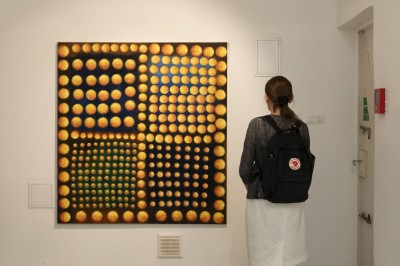Alicja Kubicka. Centre of the Universe
05.07 – 21.09.2025 Alicja Kubicka. Centre of the Universe
curator: Magda Kardasz
cooperation: Pola Gadowska
Recently, I was reminded of Peter Wolson’s essay The Vital Role of Adaptive Grandiosity in Artistic Creativity, which I found deeply inspiring. Wolson writes about the crucial role that belief in the significance of one’s own work plays in an artist’s life. This sense of value protects against succumbing to criticism and failure; the absence of it often leads to the abandonment of creative efforts altogether. By ‘grandiosity’, Wolson means the kind of inflation of the artist’s ego that is not destructive, but rather fuels the creative drive.
Alicja Kubicka
The exhibition Centre of the Universe, prepared for the Zachęta Project Room, is a kind of personal credo by the young painter Alicja Kubicka. With her characteristic sense of humour, the artist explores the origins of the creative process, revealing her paining techniques while reflecting on society’s perception of artists and the populist derision often levelled at their work for being excessive and beyond basic human needs. Time and again, she seeks to reaffirm her belief in the meaning of art and creative expression. She doubts and procrastinates in front of a blank canvas, only to rediscover the deep pleasure of painting. She writes: ‘Painting, I try to generate my own existential surplus, and I search for what feels like an unattainable compromise — a sweet spot in the stalemate between creating and living.’
Kubicka paints intuitively, following the impulses that arise in her mind. She usually starts with a large canvas composition, from which smaller pieces and three-dimensional papier mâché objects then emerge (forms that seem to have stepped out of the painting, or perhaps are three-dimensional paintings?). Kubicka has been active on the art scene for over eight years. Her works are often narrative in nature and sometimes approach abstraction, frequently incorporating symbolic elements. Universal symbols, such as the sun and clouds, intermingle with figures drawn from fairy tales, literature and popular culture. There are numerous references to the painterly craft here, such as oversized brushes and mock stretcher frames invaded by symbolic figures — a deconstructed painting that has become a painting once again. Other examples include three-dimensional landscapes (World), landscape books (Book), brushes that resemble human figures and brush tips that resemble little animals. Headless gnomes scurry about frantically. The artist’s inventiveness knows no bounds. These humorous and often borderline grotesque motifs reveal the seemingly absurd nature of the impractical act of painting.
Alicja Kubicka paints lightly — ever more lightly. She freely mixes techniques, using acrylics, gouache, dry pastels and pencils. Some parts of her compositions appear faint and almost invisible, as if smudged, while at other times the drawing is scratched into the painted layer. One of the defining features of her style is a deliberate awkwardness or ‘wonky childlike linework’ — what the artist herself calls ‘clumsy scribbliness’. She seems to suggest that a state of perpetual immaturity or naivety enables artists to maintain their belief in the significance of art. Or perhaps it is another tongue-in-cheek comment on the popular cliché that ‘artists are eternal children’. Kubicka’s style is also characterised by an impeccable sense of colour nuances and textures, and her striking ability to synthesize vision. Her work references classical genres — landscape, portrait (including self-portrait) and abstraction — but always with a twist. Her latest works, exhibited at the Zachęta Project Room, revisit familiar motifs: a schematic landscape with green grass, a blue sky and a sun above a flat horizon; a mountain; a cottage and a burning house (possibly symbolising the artist’s precarious fate); the previously mentioned proud attributes of artistic craft (brushes, but also a wand or horn); and a headless figure (a metaphor for a teacher or self-appointed mentor offering unsolicited wisdom on art and life). The exhibition also features a short film in which Kubicka flips through her sketchbooks. The artist’s ironic self-commentary offers insight into her creative process. For the exhibition, Kubicka has also created a mural which she describes as ‘a section of a model wall, a model world’. The exhibition also features an original sketchbook page with a self-portrait of the artist, holding a brush resembling a lance under her arm. This becomes a kind of emblem for Centre of the Universe, which I see as Kubicka’s declaration of faith in painting and the meaning of creation, despite everything. Another key piece is Creation of the World, in which a hand wearing a Mickey Mouse glove paints — or creates — the world. Beside it stands a sculpture titled My Conception, which allows the exhibition’s central idea of the artist as the centre of the universe to fully resonate. Finally, here are a few words from Alicja: ‘Still caught in the stage of being a “young artist”, I feel like I’m drifting at sea, at the mercy of its weather (the sea being the art world and one’s place in it), so continuing to create requires enormous belief that none of this will be in vain. It’s almost magical thinking. Imagine no one expects anything from you; there’s no promise of payment or praise on the horizon. What else can you do but blindly believe it has meaning?’
Magda Kardasz
Alicja Kubicka. Centre of the Universe
05.07 – 21.09.2025
Zachęta Project Room
ul. Gałczyńskiego 3, 00-362 Warsaw
See on the map
Godziny otwarcia:
tuesday–Sunday 12–8 p.m.
free entry
